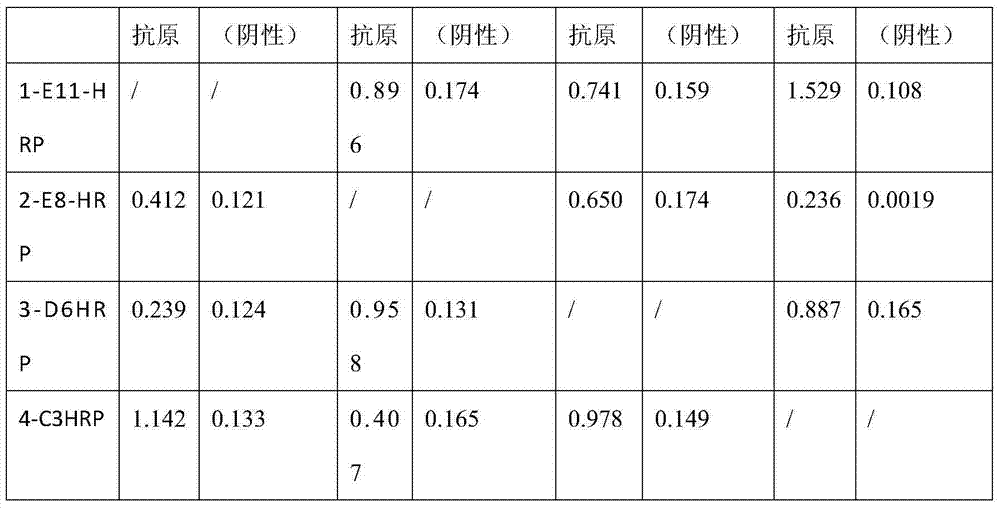Monoclonal antibody for duck tembusu virus and application
A duck Tembusu virus and monoclonal antibody technology, applied in the field of animal virology and immunology detection, can solve the problem of high repeatability, achieve good stability, convenient storage, and low detection cost
- Summary
- Abstract
- Description
- Claims
- Application Information
AI Technical Summary
Problems solved by technology
Method used
Image
Examples
Embodiment 1
[0067] The preparation of duck Tembusu virus monoclonal antibody comprises the following steps:
[0068] (1) Prepare and purify duck Tembusu virus: multiply duck Tembusu virus XN strain (isolation and identification of duck Tembusu virus XN strain, Chao Xingzhou, etc.) on chicken embryos, and collect the allantois after 72 hours solution, extract viral RNA for identification, identification is correct, ultracentrifugation, resuspension, sucrose gradient centrifugation, resuspended pellet with sterilized PBS, take a small amount again for identification, and use it as an immunogen after identification is correct.
[0069] (2) Screening of anti-duck Tembusu virus positive hybridoma cell lines:
[0070] (a) Preparation of splenocytes: emulsify 100 μg / 200 μL of duck Tembusu virus obtained in step (1) with an equal volume of complete Freund’s adjuvant and subcutaneously inject immunized female Balb / c mice aged 6 to 8 weeks; 2 One week later, immunize with 100 μg / 200 μL of purified...
Embodiment 2
[0083] An immune colloidal gold test strip for detecting duck Tembusu virus:
[0084] It consists of rigid polyvinyl chloride backing plate 1, nitrocellulose membrane 2, colloidal gold binding pad 4, sample pad 3, water-absorbing pad 5, detection line 6, and quality control line 7. It is characterized in that: nitrocellulose membrane 2 Pasted on the rigid polyvinyl chloride backing plate 1, on the left side of the nitrocellulose membrane 2, there are colloidal gold bonding pads 4, sample pads 3, and water-absorbing pads 5, which are arranged on the nitrocellulose membrane 2. The upper right position. Colloidal gold binding pad 4 is made of glass cellulose membrane, what sprayed on this colloidal gold binding pad 4 is the monoclonal antibody 1-E11 (hybridoma cell line 1-E11 of the anti-Duck Tembusu virus of colloidal gold labeling, preservation No. CCTCC NO:C2014219 secretion), the nitrocellulose membrane 2 is the detection membrane of the test strip, the upper left is the det...
Embodiment 3
[0086] A preparation method for detecting duck Tembusu virus immune colloidal gold test strip, the steps are:
[0087] (1) According to the method of Example 1, duck Tembusu virus monoclonal antibody was prepared.
[0088] (2) Prepare colloidal gold by reacting trisodium citrate with chloroauric acid: put 125mL water for injection into the silicified bottle, then add 1.2mL 1% (w / v) chloroauric acid, and heat in a microwave oven for 4 minutes; Quickly add 1.8 mL of 1.05% (w / v) trisodium citrate aqueous solution at one time, heat on medium heat for 5 minutes, and cool naturally at room temperature to obtain a colloidal gold solution. The appearance of the prepared colloidal gold is clear and transparent wine red, the spectrum at 450-600nm is scanned by a spectrophotometer, the maximum absorption wavelength is 520nm, and the particle size is uniform when observed by an electron microscope.
[0089] (3) Duck Tembusu virus monoclonal antibody colloidal gold labeling:
[0090] (a)...
PUM
 Login to View More
Login to View More Abstract
Description
Claims
Application Information
 Login to View More
Login to View More - R&D
- Intellectual Property
- Life Sciences
- Materials
- Tech Scout
- Unparalleled Data Quality
- Higher Quality Content
- 60% Fewer Hallucinations
Browse by: Latest US Patents, China's latest patents, Technical Efficacy Thesaurus, Application Domain, Technology Topic, Popular Technical Reports.
© 2025 PatSnap. All rights reserved.Legal|Privacy policy|Modern Slavery Act Transparency Statement|Sitemap|About US| Contact US: help@patsnap.com



